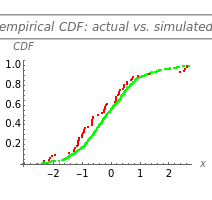Nonparametric Simulation

Requires a Wolfram Notebook System
Interact on desktop, mobile and cloud with the free Wolfram Player or other Wolfram Language products.
This Demonstration uses a simplified nonparametric process to generate a pseudorandom dataset (red) that corresponds to an "actual" dataset (green), without considering any information about the "actual" data distribution. Use the controls to change the parameters and observe how the simulated dataset fits the "actual" dataset, as well as how the dataset's PDF kernel estimations approximate the theoretical PDF.
Contributed by: Michail Bozoudis (November 2014)
Suggested by: Michail Boutsikas
Open content licensed under CC BY-NC-SA
Snapshots
Details
Nonparametric estimation is a statistical method that allows the functional form of a fit to data to be obtained in the absence of any guidance or constraints from theory. As a result, the procedures of nonparametric estimation have no meaningful associated parameters.
The simplified mechanism of this Demonstration divides the "actual" data range into uniform bins and then estimates the frequencies within each bin. These frequencies are used as weights to generate pseudorandom values within the same bin arrangement (visible in the upper histograms). The lower-left graph displays the empirical CDFs for the two datasets. Finally, in the lower-right graph, Mathematica's built-in function KernelMixtureDistribution estimates and compares the two PDF kernel estimations (green and red lines) against the theoretical PDF (dashed black line).
Permanent Citation







































